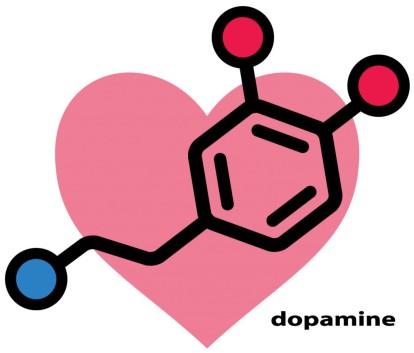With Valentine’s Day around the corner, you may be asking yourself the age-old question, “What is love?” Although this question has plagued great minds like Shakespeare and Haddaway through the centuries, modern science is getting closer to being able to find the elusive answer. It turns out that love may have less to do with the heart, and more to do with an intoxicating cocktail of neurotransmitters that flood the brain and cause “that lovin’ feeling.”
We can think about falling in love as happening over two stages, each with very specific neurotransmitter makeup: The attraction phase and the attachment phase.
The attraction phase begins with a rush of dopamine and testosterone. Dopamine is related to the brain’s pleasure center and is responsible for feelings of excitement and euphoria. If you notice that the sky seems bluer or food tastes better when you’re falling in love, dopamine may also be to blame, as it affects your level of arousal due to the stimuli around you. The testosterone that gets released increases sexual desire towards your new partner and increases feelings of aggression, which may motivate you to more actively pursue your partner.

During the attraction phase, noradrenaline also gets added to the mix, while levels of serotonin drop. Noradrenaline helps control emotions and stress – the extra dose in your system increases your alertness and attentiveness to your new partner. Serotonin helps regulate mood. The low levels in those who are newly in love can cause the obsessive thinking and heightened mood extremes often experienced in a new relationship.
As we move into the attachment phase, a feedback loop begins to form involving the brain’s reward system. Being around a new lover is associated with heightened levels of neurotransmitters and feelings of euphoria, which causes our brains to identify our partner as a source of pleasure. This causes us to crave their presence and affection more, which strengthens this association.
The attachment phase is primarily characterized by high levels of oxytocin and vasopressin. Oxytocin, also called “the cuddle chemical” is released during cuddling, kissing, and sexual behavior. This neurotransmitter causes feelings of deep trust and attachment between partners and can decrease experience of the fear response. Vasopressin is also believed to encourage bonding and support long-term sexual attraction between partners. Vasopressin also lowers feelings of anxiety when you spend time with your partner. So if you’re feeling butterflies in your stomach this Valentine’s day, don’t blame your heart, blame your head!
Resources
https://www.psychologytoday.com/blog/loves-evolver/201302/the-science-behind-falling-in-love
http://content.time.com/time/magazine/article/0,9171,993160-3,00.html


